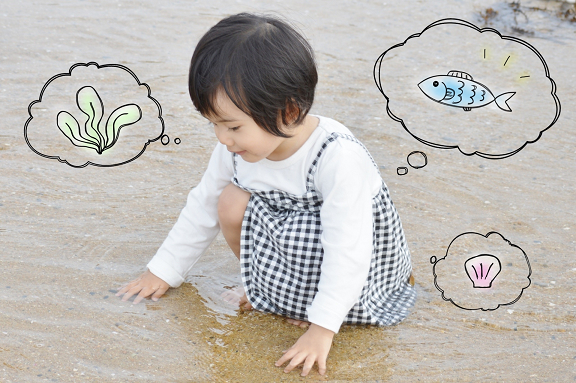Akamoku seaweed and Japanese environmental protection
1.Yet unused seaweed resources
1-1. Superfood Akamoku
1-2. Compostion of Akamoku
1-3. Akamoku as a recyclable resource
2. Akamoku and Japan’s marine environment
2-1. Seaweed as a sea maintenance tool
2-2. Examples of water quality improvement projects using Akamoku
2-3. “Rocky-shore denudation” – nationwide loss of algal beds
3. Seaweed and Carbon Dioxide
3-1. Akamoku and carbon dioxide emissions
3-2. Blue carbon in Japan
3-3. Blue Carbon Offset Scheme in Yokohama port
4. “Acamolysine™” – a bactericidal extract from akamoku
4-1. Joined project of Chubu Centrair International Airport, Tokoname City and Chubu University to utilise unused resources
4-2. New functional properties of akamoku extract
4-3. Towards environmental protection and a recycling-oriented society
1.Yet unused seaweed resources
- 1-1. Superfood Akamoku
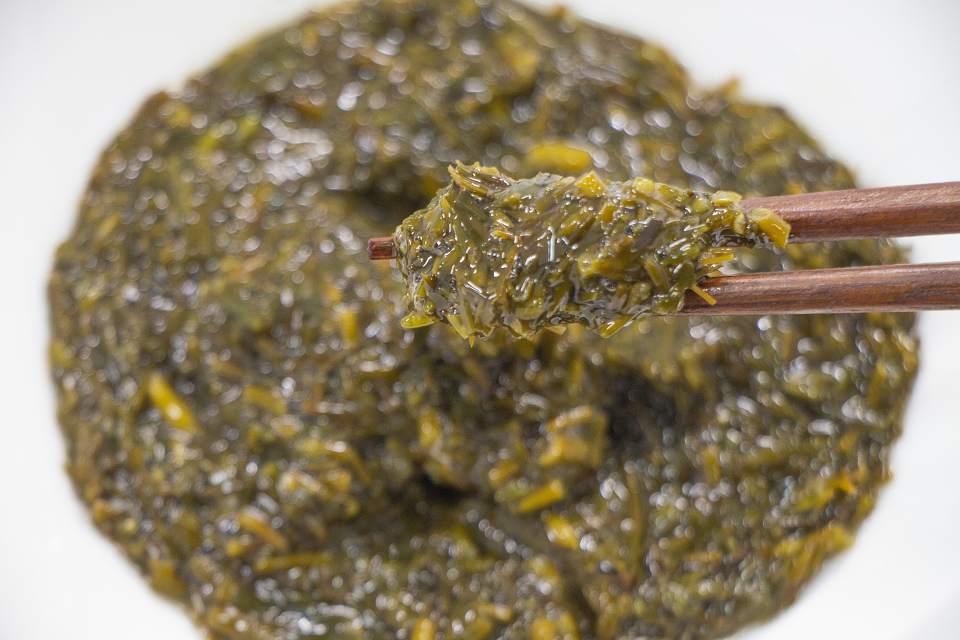
Akamoku seaweed turns from reddish-brown to bright green when boiled
Akamoku (scientific name: Sargassum horneri) is a species of brown algae belonging to the Sargassaceae family. It has attracted attention in recent years as a useful marine resource found in the seas around Japan. It has long been used as a food in some regions, and in recent years it is becoming known as one of the superfoods due to its high nutritional value and taste. Superfoods are claimed to be more nutritious and balanced than ordinary foods, and contain beneficial to health ingredients. An ordinary example of a seaweed could be kelp or wakame, whilst akamoku remains somewhat unknown, therefore it is interesting to compare their nutrition values. Despite the regional differences and seasonal harvesting the following table gives a comparison between wakame and akamoku species.
| Ingredient (per 100g) | Water (g) | Proteins (g) | Fats (g) | Carbohydrates (g) | Minerals (g) | Na (mg) | K (mg) | Ca (mg) | Mg (mg) | Fe (mg) | Zn (mg) | Cu (mg) | Mn (mg) |
|---|---|---|---|---|---|---|---|---|---|---|---|---|---|
| Dried wakame1 | 12.7 | 13.6 | 1.6 | 41.3 | 30.8 | 6,600 | 5,200 | 780 | 1,100 | 2.6 | 0.9 | 0.08 | 0.32 |
| Dried akamoku2 | 12.1 | 13.8 | 3.2 | 63 | 20.0 | 4,585 | 9,710 | 893 | 757 | 13.5 | 5.69 | 0.47 | 2.34 |
2Araki et al, Journal of the Japanese Society of Culinary Science, vol. 38, no. 1, 2005.
Akamoku is high in potassium and trace elements (manganese, copper, zinc) which tends to be in short supply due to reduced intake of vegetables and minerals. In terms of safety, akamoku is considered to be safe to consume as it has been a part of traditional Japanese cuisine for a long time.
- 1-2. Compostion of Akamoku
In addition to nutrients above, the following Akamoku components are also known for their health benefits.
Fucoidan is a type of polysaccharide abundant in brown algae. Its molecular structure contains sulphate groups that have been reported to have anti-tumour activity. The dietary fibre in Akamoku consists mainly of fucoidan, alginic acid, cellulose (a cell wall component) and laminaran (an energy-storing polysaccharide), with fucoidan ranging from 1.02-8.31 g per 100 g dry Akamoku, depending on the time of harvest3. One possible explanation for such concentration range is because fucoidan production tends to increase more rapidly when the seaweed matures and becomes fertile, compared to the growing season.
Alginic acid is a dietary fibre edible polysaccharide found in brown algae, known as an algae’s water-holding component. In Japan sodium salt of alginic acid (sodium alginate) has food safety label for “regulating stomach flora and high cholesterol levels”. Similarly, calcium alginate, although having no water retention properties, is known for to “suppressing elevated blood sugar levels and is used as an ingredient in various functional food products.
Fucoxanthin Brown algae have two known pigments: green chlorophyll and brown fucoxanthin. When the coloured algae are boiled, the fucoxanthin is dissolved out and the brown colour changes to a bright chlorophyll green. Fucoxanthin is known to have various health benefits, including antioxidant and anti-tumour effects, as well as body fat regulation. Akamoku is reported to contain 16.5 mg of fucoxanthin per 100 g.4
Dietary fibre Polysaccharides that cannot be completely broken down by human digestive enzymes are called dietary fibre, and are mainly used as food for intestinal bacteria or expelled as stool bulk. Akamoku is reported to contain 38.3 g of dietary fibre per 100 g which fucoidan, alginic acid, cellulose, and laminaran.5
Polyphenols are naturally occuring organic compounds that are found mainly in plants, where they protects plant from ultraviolet radiation. Polyphenols are also known to have various health benefits when ingested by humans. Wakame seaweed is generally known for its high polyphenol content (31.02 mg per 100 g), however, recently akamoku was reported to contain three times as much polyphenol.5
Akamoku is also rich in various minerals such as manganese, copper, and zinc.
(References)
3Kimura et al., Nippon Suisan Gakkaishi vol. 73, ed. 4, 2007
4Kanazawa K., Journal of the Japanese Society for Food Science and Technology vol. 59, ed. 2, 2012
5Taniguchi et al., Journal of Home Economics of Japan vol. 70, ed. 3, 2019
- 1-3. Akamoku as a recyclable resource
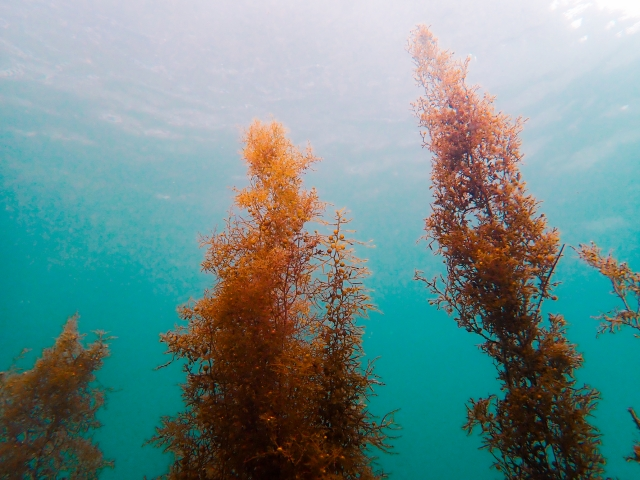
Akamoku are an annual species of algae in Sargassaceae family that live mainly on rocky reefs. As any other algae, it absorbs absorbs phosphorus and nitrogen, which cause eutrophication of the oceans. However, it as also an annual plant and if not harvested it is decomposed by micro-organisms, returning the phosphorus and nitrogen content back to the ocean. Based on that it can be assumed that a virtuous cycle between Akamoku and water purification can be created by harvesting and increasing industrial utilisation of the Akamoku during the growing season from early spring to early summer, when the absorption rate of phosphorus and nitrogen is at its maximum. By increasing the industrial use of Akamoku the amount of landings and Akamoku growth factor will increase, potenteally making ocean more clean. Various projects are currently under way across Japan to make better use of Akamoku.
2.Akamoku and Japan’s marine environment
- 2-1. Seaweed as a sea maintenance tool
As previously mentioned, Akamoku can grow to a size of five metres in just one year compared to other species of the same family, it is washed out as drift algae, making it an extremely vigorous seaweed.
- 2-2. Examples of water quality improvement projects using Akamoku
Effectiveness of akamoku in improving water quality has been confirmed not only in the laboratory, but also a recent study has investigated and confirmed whether it can actually improve water quality in the ocean. The research was conducted in Matsushima Bay, Miyagi Prefecture, one of the most picturesque spots in Japan. Matsushima Bay is made up of 260 islands, which block the flow of the open sea, causing frequent pollution such as red tides. In response to this, Miyagi Prefecture and Tohoku University conducted a demonstration test between 2002 and 2008 to improve water quality in Matsushima Bay. They created akamoku seaweed bed which proved to be effective in improving water quality (see website for reference).
It has also been reported that certain polyphenols produced by akamoku inhibit the growth of skeletonema costatum, a type of phytoplankton that causes red tides. Two effects of improving water quality and inhibiting the growth of harmful micro-organisms reduce oxygen consumption in the ocean, creating a habitable environment for fish, shellfish and many other organisms.6
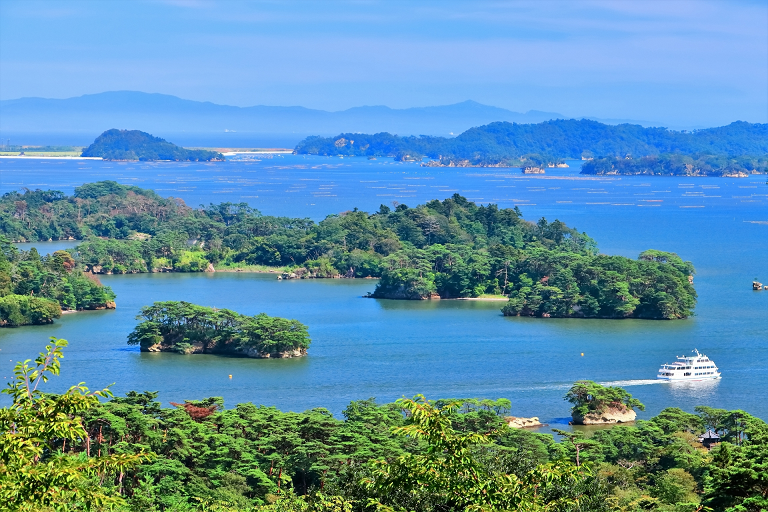
(References)
6Takeda et al., Journal of Japan Biiological Society of Water and Waste. Extra issue (24), 49, 2004-10-15
(Miyagi Prefecture official website)
https://www-pref-miyagi-jp.translate.goog/?_x_tr_sl=ja&_x_tr_tl=en&_x_tr_hl=ja&_x_tr_pto=nui
- 2-3.”Rocky-shore denudation” – nationwide loss of algal beds
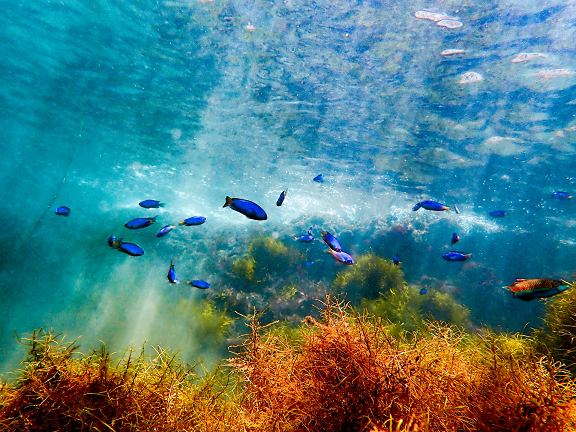
According to a report in 1994 (Nature Conservation Bureau, Environment Agency) the Japanese coastline has lost 6,400 ha of seaweed beds, which were habitats for various aquatic organisms, since 1978 as 48% of shallow areas were reduced by artificial reclamation and installation of facilities.7 In 1991, the seaweed beds known as galamo beds containing akamoku were the largest (27.1%) in the country, covering 85,682 ha. However in the period of 13 years since 1978, 2,315 ha (22%) of galamo beds have been reported to be lost.8 In the existing shallow-water areas, the major problem is so called “rocky-shore denudation”, in which seaweed beds wither and decline over a long period of time due to an imbalance in the ecosystem. It has been reported that as much as 22% of the total algae beds were lost between 1990 and 2008 (Marine Biological and Environmental Laboratory Report 2009). The loss of seaweed beds and occurrence of red tides leads to the depletion of fish and shellfish resources. In recent years the Fisheries Agency has taken the lead in releasing technical documents such as the “Guidelines on measures against rocky-shore denudation” and there has been an increase in efforts to create seaweed beds in various regions.
(References)
6Takeda et al., Journal of Japan Biiological Society of Water and Waste. Extra issue (24), 49, 2004-10-15
(Miyagi Prefecture official website)
7Hasegawa Kazuyuki Marine Ecology Research Institute News, April, 2009
8Ministry of the Environment Fourth Basic Survey on the Conservation of the Natural Environment Marine Biological Environment Survey Report, Volume 2: Seaweed beds.
(External website, available only in Japanese)
https://www.biodic.go.jp/kiso/34/34_higat.html#mainText
3. Seaweed and Carbon Dioxide
- 3-1. Akamoku and carbon dioxide emissions
Algae, including akamoku, absorb carbon dioxide and sequester it the same way as plants do. The largest greenhouse gas involved in global warming is carbon dioxide, which accounts for 76% of the total emissions. As with plants, the carbon that makes up the body of seaweed is composed of absorbed carbon dioxide that is converted, so the amount of carbon dioxide absorbed by seaweed can be estimated by examining the carbon content of the algal body. On the other hand, photosynthesis is used to produce oxygen, absorbing carbon dioxide, while this oxygen is being used in respiration process to produce energy and exhaling carbon dioxide back. Therefore, by subtracting the amount of carbon dioxide released through respiration from the amount of carbon dioxide absorbed through photosynthesis, the ‘absorption potential amount’ that seaweed can absorb purely from atmospheric carbon dioxide can be calculated. In practice, the calculation model is complex, but approximate estimates range from 0.8 to 3.6 tons CO2/ha/year for kelp fields, 2.3 to 10 tons CO2/ha/year for arame and swordfish fields and 5.1 to 15 tons CO2/ha/year for seaweed bed.9 Akamoku is classified as a seaweed bed and is reported to have an absorption potential of about 10 tons CO2/ha/year, which is a large part comparing to other seaweed species.
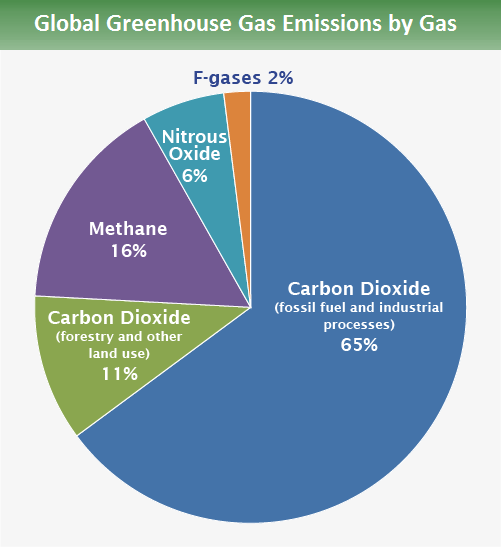
- 3-2.Blue carbon in Japan
Carbon dioxide absorbed by land plants through photosynthesis is called “green carbon”, whereas carbon dioxide absorbed by marine organisms such as seaweed is called “blue carbon”. Japan has a land area of 370,000 km2, ranking it only 62nd country in the world, however when it comes to ocean area, it has a large area with a total of 4.47 million km2, – a promising value for ocean carbon deposition.9 Blue carbon is the carbon amount that can be captured by seaweed and seagrass beds, wetlands and tidal flats, mangrove forests and phytoplankton. Currently, seaweed, wetlands and tidal flats in shallow waters are the main sources of blue carbon that humans can control.
(References)
9Central Research Institute of Electric Power Industry report, “Estimation of CO2 sequestration potential based on case studies of rocky seagrass beds”, Mar 2021.
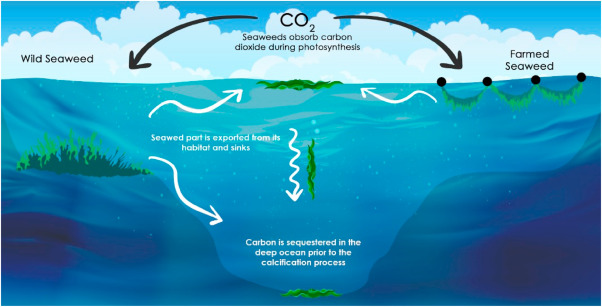
- 3-3.Blue Carbon Offset Scheme in Yokohama port
Let’s take a look at an example of how akamoku is actually being used for blue carbon capturing in Japan. In Japan, various initiatives are underway to become carbon neutral by 2050 and to achieve a decarbonised society. The Ministry of Land, Infrastructure, Transport and Tourism (MLIT) is organising study groups in six country’s most used water ports with the aim to achieve carbon neutrality. The Blue Carbon Offset Scheme is being trialled through a seaweed bed creation project in one of these locations – the Torihama area of Kanazawa Ward, Port of Yokohama. The scheme project certifies the amount of CO2 (blue carbon) absorbed by marine organisms as credits and trades these credits with companies and organisations that are trying to reduce CO2 emissions. This way is expected to enhance seaweed bed development and improvement of the local marine environment and ecosystem.
4. ”Acamolysine™” – a bactericidal extract from akamoku.
- 4-1. Joined project of Chubu Centrair International Airport, Tokoname City, and Chubu University to utilise unused resources
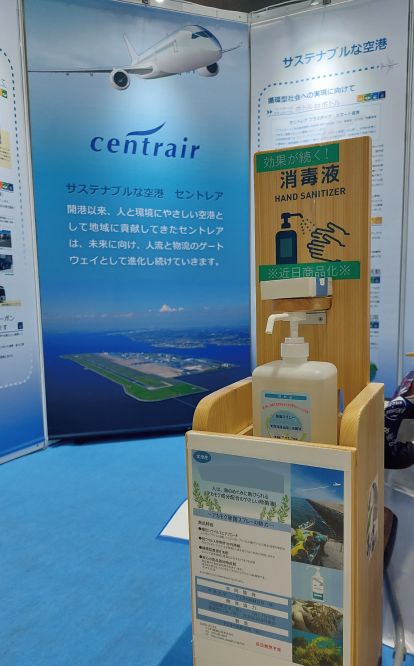
Nagoya Port is the largest trading port in Japan. From the largest port in Japan in the city of Nagoya down the Chita Peninsula to the south, there is a Chubu Centrair International Airport, surrounded by waters of Tokoname City. The airport is located in the centre of Japan and plays an important role as a transport hub for a wide range of domestic and international traffic. However, being a marine airport, it is also committed to protecting the marine environment and maintaining biodiversity. Research collaborations on the akamoku usage have been promoted together with Chubu University and the Tokoname Fisheries Cooperative Society with the aim of “protecting the environment and utilising unused marine resources”. As a result, Chubu University demonstrated that the extracted component of akamoku effectively inhibits viral growth, which led to joint research and production of new antiviral material “Acamolysine™” by Yaegaki Biotechnology.
- 4-2. New functional properties of akamoku extract
The following are the results of a joint study with Chubu University on the Virucidal effects of “Acamolysine™” and its ethanol formulations.
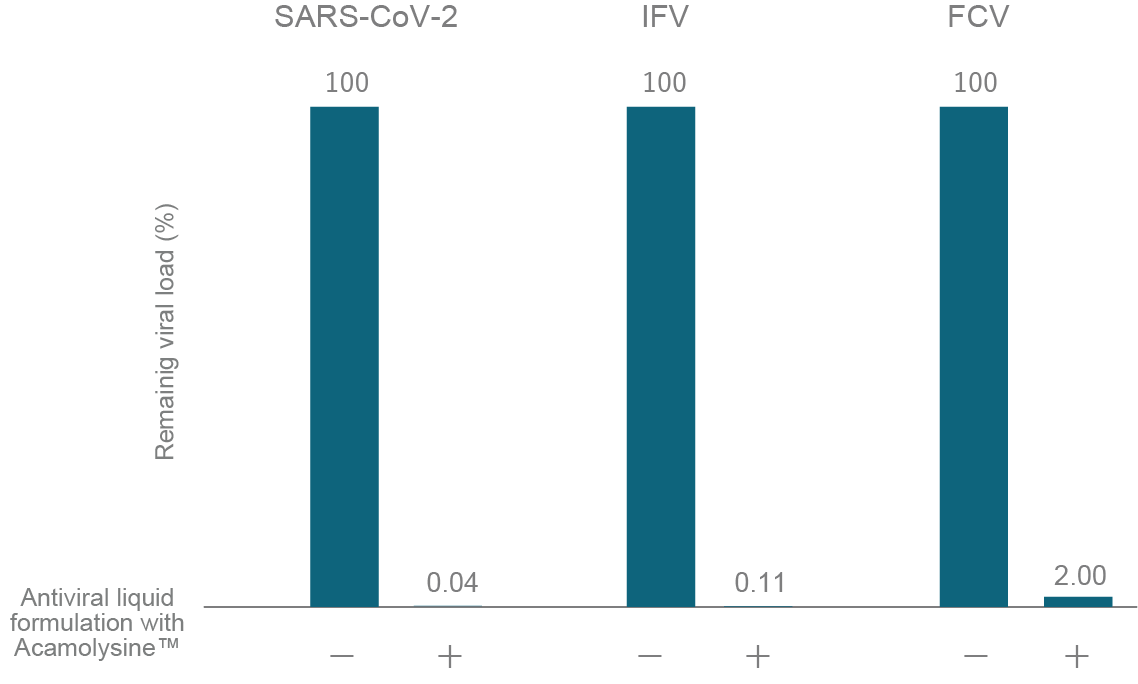
| Trial Outline | |
|---|---|
| Subjects | Experiment group (Antiviral solution containing Acamolysine™) Control group (buffer solution PBS) |
| Types of viruses | SARS-CoV-2 : novel coronavirus IFV : Influenza A virus FCV : Feline calicivirus |
| Procedure of cell infection | 1) 0.9 ml of antiviral solution containing “Acamolysine™”TM or PBS (control) were mixed with 0.1 ml of 10 times concentrated viral solution (final volume 1×106 PFU/mL) (mixing ratio 9:1). 2) After 10 seconds, a portion were taken out, diluted 10-1000 times, and added to the host cells at 0.1 mL/dish for 1 hour at room temperature. 3) Formed viral plaques were cultivated in CO2 incubator. |
| Plaque counting | After 1 day for FCV and 2 days for IFV and SARS-CoV-2 respectively, the plaques were counted under microscope using formalin-fixation and staining with crystal violet solution. Remaining viral load in % was determined assuming, that plaque count in control group (PBS) immediately after virus mixing (0 min) as total viral count (100%). |
The virucidal effect of ethanol formulations containing “Acamolysine™” was confirmed for two types of enveloped viruses (SARS-CoV-2 and IFV) and one type of non-enveloped virus (FCV). Antiviral effect was sustained for one month after the alcohol evaporation most likely due to organic extract of “Acamolysine™” compound.
- 4-3. Towards environmental protection and a recycling-oriented society
We believe that the new functionality of akamoku is beneficial as an infection prevention measure at Chubu Centrair International Airport, where international interactions happen on a regulat basis, and can be a good example of how to tackle environmental issues in local communities. In addition to seaweed functional materials Yaegaki Biotechnology also offers a wide range of plant-based food ingredients and natural colourants, and will continue to promote research and development in collaboration with industry, academia and government in order to form a sustainable society through via original technologies developed over many years.
